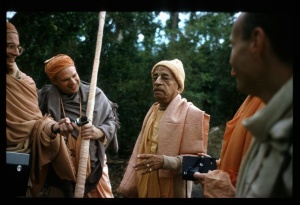CC Madhya 7.63

A.C. Bhaktivedanta Swami Prabhupada
TEXT 63
śūdra viṣayi-jñāne upekṣā nā karibe
āmāra vacane tāṅre avaśya milibe
SYNONYMS
śūdra—the fourth social division; viṣayi-jñāne—by the impression of being a worldly man; upekṣā—negligence; nā karibe—should not do; āmāra—my; vacane—on the request; tāṅre—him; avaśya—certainly; milibe—You should meet.
TRANSLATION
“Please do not neglect him, thinking he belongs to a śūdra family engaged in material activities. It is my request that You meet him without fail.”
PURPORT
In the varṇāśrama-dharma, the śūdra is the fourth division in the social status. Paricaryātmakaṁ karma śūdrasyāpi svabhāva-jam (BG 18.44). Śūdras are meant to engage in the service of the three higher classes—brāhmaṇas, kṣatriyas and vaiśyas. Śrī Rāmānanda Rāya belonged to the karaṇa class, which is the equivalent of the kāyastha class in Bengal. This class is regarded all over India as śūdra. It is said that the Bengali kāyasthas were originally engaged as servants of brāhmaṇas who came from North India to Bengal. Later, the clerical class became the kāyasthas in Bengal. Now there are many mixed classes known as kāyastha. Sometimes it is said in Bengal that those who cannot claim any particular class belong to the kāyastha class. Although these kāyasthas or karaṇas are considered śūdras, they are very intelligent and highly educated. Most of them are professionals such as lawyers or politicians. Thus in Bengal the kāyasthas are sometimes considered kṣatriyas. In Orissa, however, the kāyastha class, which includes the karaṇas, is considered in the śūdra category. Śrīla Rāmānanda Rāya belonged to this karaṇa class; therefore he was considered a śūdra. He was also the governor of South India under the regime of Mahārāja Pratāparudra of Orissa. In other words, Sārvabhauma Bhaṭṭācārya informed Lord Caitanya Mahāprabhu that Rāmānanda Rāya, although belonging to the śūdra class, was a highly responsible government officer. As far as spiritual advancement is concerned, materialists, politicians and śūdras are generally disqualified. Sārvabhauma Bhaṭṭācārya therefore requested that Lord Caitanya Mahāprabhu not neglect Rāmānanda Rāya, who was highly advanced spiritually although he was born a śūdra and a materialist.
A viṣayī is one who is attached to family life and is interested only in wife, children and worldly sense gratification. The senses can be engaged either in worldly enjoyment or in the service of the Lord. Those who are not engaged in the service of the Lord and are interested only in material sense gratification are called viṣayī. Śrīla Rāmānanda Rāya was engaged in government service, and he belonged to the karaṇa class. He was certainly not a sannyāsī in saffron cloth, yet he was in the transcendental position of a paramahaṁsa householder. Before becoming Caitanya Mahāprabhu’s disciple, Sārvabhauma Bhaṭṭācārya considered Rāmānanda Rāya an ordinary viṣayī because he was a householder engaged in government service. However, when the Bhaṭṭācārya was actually enlightened in Vaiṣṇava philosophy, he could understand the exalted transcendental position of Śrī Rāmānanda Rāya; therefore he referred to him as adhikārī. An adhikārī is one who knows the transcendental science of Kṛṣṇa and is engaged in His service; therefore all gṛhastha devotees are designated as dāsa adhikārī.